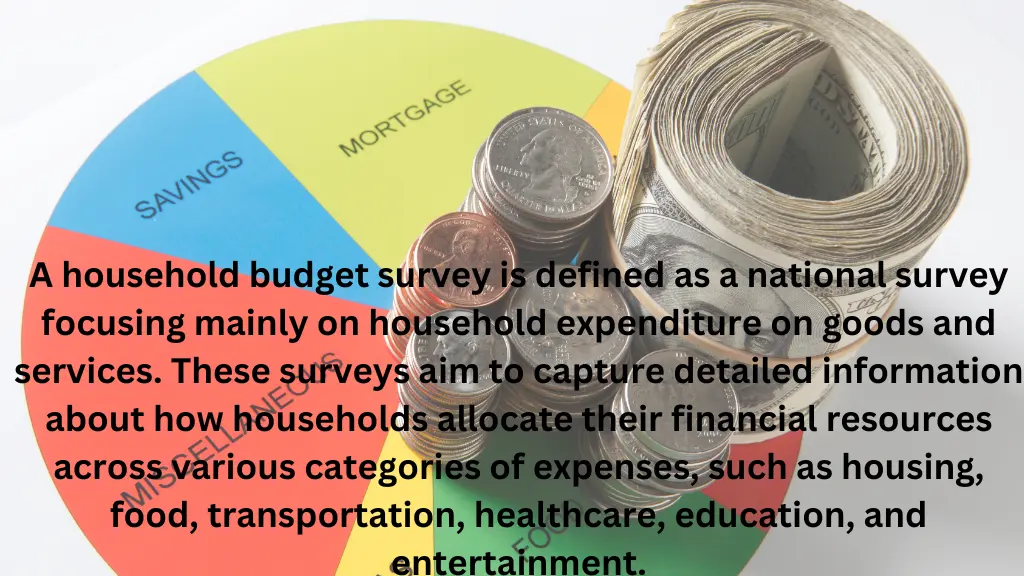A household budget survey is a comprehensive national survey that focuses primarily on capturing household expenditures on goods and services.
These surveys provide invaluable insights into the financial realities and spending patterns of households across different income levels, geographic regions, and demographic profiles.
A household budget survey is a tool used by governments and statistical agencies to collect data on how households allocate their resources across various expenditure categories, such as housing, food, transportation, healthcare, and education.
In this article, we will delve into the intricacies of household budget surveys, exploring their methodologies, expenditure categories, applications, challenges, and future perspectives.
We will also examine how these surveys contribute to policymaking, economic analysis, market research, and academic studies, ultimately offering a comprehensive understanding of this powerful data-collection tool.

What is Household Budget Survey?
A household budget survey is defined as a national survey focusing mainly on household expenditure on goods and services. These surveys aim to capture detailed information about how households allocate their financial resources across various categories of expenses, such as housing, food, transportation, healthcare, education, and entertainment.
National Household Budget Surveys
Imagine a massive jigsaw puzzle, where each household represents a piece, and together, they form a vivid picture of a nation’s financial landscape. National household budget surveys are like the master craftsmen assembling this puzzle, meticulously collecting and analyzing data on how households allocate their resources across various expenditure categories.
These surveys are conducted periodically, typically annually or multi-yearly, by statistical agencies or government bodies responsible for gathering economic data.
Their primary objective is to capture the spending patterns, consumption habits, and financial well-being of households across different income levels, geographic regions, and demographic profiles.
A Glimpse into Household Finances
So, what kind of information do these surveys uncover? Think of it as a financial biography of a household, chronicling their journey through the intricate maze of expenditures.
From the groceries that fill their pantries to the rent or mortgage payments that keep a roof over their heads, from the utility bills that power their homes to the transportation costs that keep them on the move – every penny spent is accounted for and analyzed.
But wait, there’s more! These surveys also delve into the income sources that fuel these expenditures, whether it’s employment wages, business profits, rental income, or government assistance programs. It’s a holistic approach that paints a comprehensive picture of a household’s financial reality.
Survey Methodology
Like any scientific endeavor, household budget surveys employ rigorous methodologies to ensure the accuracy and reliability of the data collected. Here’s a quick peek into the process:
Sampling Strategies
Imagine trying to survey every single household in a nation—it would be impossible! That’s why these surveys rely on representative sampling techniques, carefully selecting a portion of households that accurately reflect the diversity of the population.
This could involve stratified sampling based on factors like income levels, geographic regions, or demographic characteristics.
Data Collection Methods
The art of gathering data is a delicate dance, and household budget surveys employ a variety of techniques to capture the intricate details of household finances. These could include:
- Interviews: Trained enumerators visit selected households and conduct face-to-face interviews, meticulously recording every response.
- Diaries: Households are provided with detailed expenditure diaries, where they diligently log their daily purchases and expenses over a specified period.
- Online Surveys: In our increasingly digital world, some surveys leverage the power of the internet, allowing households to report their financial information conveniently through secure online portals.
Regardless of the method chosen, rigorous quality control measures are implemented to ensure the accuracy and completeness of the data collected.
Expenditure Categories
But what exactly do these surveys track? Well, imagine a massive spreadsheet with rows upon rows of expenditure categories, each telling a unique story about how households allocate their resources. Let’s take a closer look at some of the main categories:
| Category | Description |
|---|---|
| Housing | This encompasses rent or mortgage payments, utilities, maintenance, and repairs. |
| Food and Beverages | From groceries to dining out, this category captures the cost of sustaining our culinary cravings. |
| Transportation | Fuel, public transit, vehicle maintenance – anything that keeps us on the move falls into this bucket. |
| Healthcare | Medical expenses, insurance premiums, and other costs related to maintaining our well-being. |
| Education | Tuition fees, textbooks, and other educational expenses for household members. |
| Recreation and Entertainment | Because even budgets need a little fun, this category covers leisure activities and entertainment expenses. |
And the list goes on, with categories like clothing, communication, personal care, and more, each offering a window into the diverse financial realities of households across the nation.
The Devil’s in the Details
But wait, there’s more! These surveys don’t just stop at broad categories; they dive deep into the intricate details, capturing the nuances of household expenditures.
For instance, the food category might be further broken down into subcategories like groceries, dining out, and even specific food items like bread, meat, or vegetables.
It’s this level of granularity that allows policymakers and researchers to truly understand the complexities of household budgets and identify patterns and trends that might otherwise go unnoticed.
Household Characteristics
Expenditure data alone only tells part of the story. To truly understand the “why” behind the spending patterns, household budget surveys also collect a wealth of demographic and socioeconomic information about the households themselves. This contextual data adds depth and richness to the analysis, allowing for more nuanced insights.
Some of the vital household characteristics captured in these surveys include:
- Household Size and Composition: The number of members, their ages, and relationships within the household.
- Income Levels and Sources: Employment status, wages, business income, government assistance, and other revenue streams.
- Educational Attainment: The highest level of education achieved by household members.
- Geographic Location: Urban, suburban, or rural areas, as well as specific regions or states.
- Housing Tenure: Whether the household rents or owns its residence.
By cross-referencing expenditure data with these household characteristics, analysts can uncover fascinating patterns and insights.
For instance, they might discover that larger households with children tend to allocate a higher portion of their budget towards education and recreation or that households in specific geographic regions spend more on transportation due to commuting distances.
Data Analysis and Interpretation
With mountains of data collected from households across the nation, the real magic happens when statisticians and economists roll up their sleeves and dive into the analysis and interpretation phase. But how do they make sense of this vast financial tapestry woven by households?
Statistical Wizardry
Get ready to witness some serious number crunching! Analysts employ a wide array of statistical techniques to unravel the insights hidden within the data.
From calculating averages and percentages to conducting regression analyses and modeling exercises, these quantitative wizards leave no stone unturned.
But it’s not just about the numbers – data visualization plays a crucial role in bringing the findings to life. Imagine vibrant charts, graphs, and infographics that tell a story with every line and color, making complex financial data accessible and easily digestible.
Identifying Trends and Patterns
One key objective of data analysis is to identify trends and patterns that might not be immediately apparent. By slicing and dicing the data across various dimensions—income levels, geographic regions, household compositions, and more—analysts can uncover fascinating insights.
For instance, they might discover that households in a particular income bracket allocate a disproportionate amount of their budget towards housing, indicating potential affordability challenges.
They might also notice a shift in spending patterns towards online shopping and digital services, reflecting the impact of technological advancements on consumer behavior.
These discoveries not only illuminate current realities but also inform projections and forecasting models, allowing policymakers and businesses to anticipate future trends and plan accordingly.
Applications and Uses
Market Research and Product Development
In the realm of business and commerce, household budget survey data is akin to striking gold. Imagine being a product manufacturer or service provider, constantly striving to stay ahead of the curve and cater to the ever-evolving needs and preferences of consumers.
With access to detailed expenditure patterns across various product categories, you gain an invaluable competitive edge.
Market researchers can leverage this data to identify emerging trends, pinpoint target demographics, and develop products and services tailored to specific household segments.
From the food and beverage industry to consumer electronics, from automotive to travel and leisure – the possibilities are endless when you have a deep understanding of how households allocate their hard-earned dollars.
Academic Research and Policy Analysis
Beyond the realms of government and business, household budget survey data serves as a rich resource for academic researchers and policy analysts alike.
These intellectual trailblazers delve into the data, seeking to uncover deeper insights and answer pressing questions about household behavior, consumption patterns, and their broader economic and social implications.
Imagine a team of economists exploring the intricate relationship between income inequality and household expenditure decisions or a sociologist investigating the impact of cultural factors on spending habits.
With access to this wealth of data, academic researchers can contribute to the advancement of knowledge, challenge existing theories, and shape the discourse around critical issues affecting households and society as a whole.
Challenges and Limitations
While household budget surveys undoubtedly provide invaluable insights, conducting these massive undertakings is not without its challenges and limitations.
Let’s take a candid look at some of the hurdles that statisticians and survey administrators must navigate.
Response Bias and Underreporting
One of the biggest challenges in any survey is response bias – the tendency for respondents to provide inaccurate or incomplete information, whether intentionally or unintentionally.
In the context of household budgets, this could manifest in the form of underreporting certain expenditures, especially those deemed sensitive or socially undesirable.
Imagine a household that underestimates its spending on vices like alcohol or gambling or fails to account for irregular or informal income sources.
These biases can skew the data and lead to inaccurate conclusions if not properly addressed through rigorous data validation and quality control measures.
Survey Fatigue and Non-Response
Let’s face it – participating in a comprehensive household budget survey can be a time-consuming and demanding endeavor.
Households are asked to meticulously document and report every penny spent over an extended period, often requiring significant effort and dedication.
As a result, survey fatigue can set in, leading to incomplete or inaccurate responses or, worse yet, households dropping out of the survey altogether.
This non-response bias can further compromise the representativeness of the data, mainly if specific segments of the population are more likely to opt out than others.
To mitigate these challenges, survey administrators employ a range of strategies, from offering incentives and reminders to leveraging technology to simplify the reporting process. It’s a delicate balance between maximizing participation and minimizing the burden on respondents.
Resource Constraints and Budgetary Limitations
Conducting a national household budget survey is a mammoth undertaking, requiring significant resources in terms of personnel, logistics, and technology.
From training and deploying field enumerators to developing secure data collection platforms, the costs can quickly add up, especially for countries with limited budgets.
Budgetary constraints can impact the frequency, scope, and quality of these surveys, potentially leading to outdated or incomplete data.
Striking the right balance between operational efficiency and data accuracy is an ongoing challenge that survey administrators must navigate.
International Comparisons

In our increasingly interconnected world, the ability to compare and contrast household expenditure patterns across borders has become increasingly valuable.
Imagine being able to understand how households in different countries allocate their resources or how cultural and economic factors influence spending decisions on a global scale.
While the concept of household budget surveys is universal, methodologies, definitions, and data collection practices can vary significantly from country to country. This poses a unique challenge when it comes to making meaningful international comparisons.
Harmonization and Standardization Efforts
To address this challenge, international organizations, and statistical bodies have undertaken concerted efforts to harmonize and standardize household budget survey practices across nations.
Initiatives like the International Comparison Program (ICP) and the Household Budget Survey Network (HBSN) aim to establish common frameworks, definitions, and methodologies, facilitating cross-country comparisons and analysis.
These harmonization efforts involve collaborative partnerships, knowledge sharing, and the development of best practices, ensuring that data collected in different countries is as comparable and consistent as possible.
Cross-Cultural Considerations
However, even with harmonized methodologies, cultural nuances and differences in household dynamics can still pose challenges when making international comparisons.
For instance, the concept of a “household” itself may vary across cultures, with extended families or multi-generational households being more common in certain regions.
Additionally, cultural norms and preferences can influence expenditure patterns, with some societies placing greater emphasis on specific categories like education, healthcare, or entertainment. Accounting for these cross-cultural nuances is crucial when interpreting and comparing household budget data on a global scale.
Future Perspectives
As we journey through the ever-evolving landscape of household finances, it’s essential to look ahead and anticipate the future directions and innovations that will shape the world of household budget surveys.
Technological Advancements
One of the most exciting frontiers is the integration of cutting-edge technologies into the data collection process.
Imagine households using mobile apps or wearable devices to seamlessly track and report their expenditures in real time, eliminating the need for tedious manual recording.
Furthermore, advancements in data analytics and machine learning could revolutionize the way we analyze and interpret household budget data, uncovering patterns and insights that were previously hidden.
New Data Sources and Big Data Integration
While traditional survey methods remain crucial, the future may also involve leveraging alternative data sources to complement and enrich household budget information.
From electronic payment records to social media data and online purchase histories, the possibilities are vast.
By integrating these diverse data streams through advanced big data techniques, statisticians and researchers could gain a more holistic and real-time understanding of household expenditure behavior, transcending the limitations of periodic surveys.
Increased Focus on Sustainability and Environmental Impact
As the world grapples with the pressing challenges of climate change and environmental degradation, future household budget surveys may place a greater emphasis on capturing data related to sustainable consumption patterns and environmental impact.
Imagine surveys that not only track expenditures on goods and services but also measure the carbon footprint associated with those purchases or household investments in renewable energy and eco-friendly products.
This data could inform policies and initiatives aimed at promoting sustainable lifestyles and reducing the environmental impact of household consumption.
Conclusion
As we bid farewell to our journey through the realm of household budget surveys, it’s clear that these powerful tools offer far more than just a compilation of numbers and statistics.
They provide a window into households’ financial lives, shedding light on the intricate dance between income and expenditure and revealing the stories woven into every purchase decision.
Whether it’s policymakers striving to support vulnerable communities, businesses seeking to stay ahead of consumer trends, or researchers unraveling the complexities of household behavior, the insights gleaned from these surveys are invaluable.
Yet, as we’ve explored, conducting these surveys is no simple feat. It requires meticulous planning, rigorous methodologies, and a commitment to overcoming challenges such as response bias, survey fatigue, and resource constraints.
As we look to the future, technological advancements, the integration of new data sources, and a heightened focus on sustainability and environmental impact will undoubtedly shape the evolution of household budget surveys.
The potential for innovation is vast, and the insights gained will be instrumental in guiding policy, shaping markets, and fostering a deeper understanding of the intricate tapestry that is household finance.
So, the next time you make a purchase or pay a bill, remember – you’re not just engaging in a transaction; you’re part of a larger story, one that household budget surveys strive to capture and understand.
It’s a story that interweaves the personal with the national, the individual with the collective, and every penny spent holds a tale worth telling.





